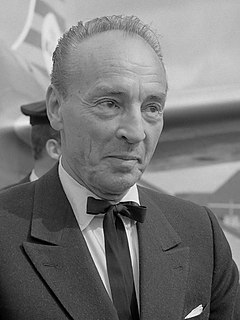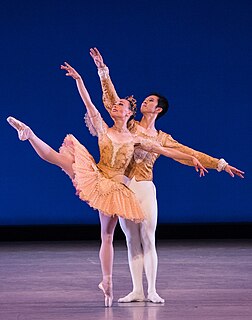Related Research Articles

George Balanchine was an American ballet choreographer who was one of the most influential 20th-century choreographers. Styled as the father of American ballet, he co-founded the New York City Ballet and remained its Artistic Director for more than 35 years. His choreography is characterized by plotless ballets with minimal costume and décor, performed to classical and neoclassical music.

Elizabeth Marie Tallchief was an American ballerina. She was considered America's first major prima ballerina. She was the first Native American to hold the rank, and is said to have revolutionized ballet.
Gelsey Kirkland is an American ballerina. She received early ballet training at the School of American Ballet. Kirkland joined the New York City Ballet in 1968 at age 15, at the invitation of George Balanchine. She was promoted to soloist in 1969, and principal in 1972. She went on to create leading roles in many of the great twentieth century ballets by Balanchine, Jerome Robbins, and Antony Tudor, including Balanchine's revival of The Firebird, Robbins' Goldberg Variations, and Tudor's The Leaves are Fading. Balanchine re-choreographed his version of Stravinsky's The Firebird specifically for her. She left the New York City Ballet to join the American Ballet Theatre in 1974 as a principal dancer.

Violette Verdy was a French ballerina, choreographer, teacher, and writer who worked as a dance company director with the Paris Opera Ballet in France and the Boston Ballet in the United States. From 1958 to 1977 she was a principal dancer with the New York City Ballet where she performed in the world premieres of several works created specifically for her by choreographers George Balanchine and Jerome Robbins. She was Distinguished Professor of Music (Ballet) at the Jacobs School of Music, Indiana University, in Bloomington, and the recipient of two medals from the French government.

The company Ballets Russes de Monte-Carlo was formed in 1932 after the death of Sergei Diaghilev and the demise of Ballets Russes. Its director was Wassily de Basil, and its artistic director was René Blum. They fell out in 1936 and the company split. The part which de Basil retained went through two name changes before becoming the Original Ballet Russe. Blum founded Les Ballets de Monte Carlo, which changed its name to Ballet Russe de Monte-Carlo when Léonide Massine became artistic director in 1938. It operated under this name until it disbanded some 20 years later.

Élisabeth Platel is a French prima ballerina.
Kenneth von Heidecke was an American dancer, choreographer, and the founder and artistic director of Von Heidecke's Chicago Festival Ballet and Von Heidecke School of Ballet.

Nicholas Magallanes was a principal dancer and charter member of the New York City Ballet. Along with Francisco Moncion, Maria Tallchief, and Tanaquil Le Clercq, Magallanes was among the core group of dancers with which George Balanchine and Lincoln Kirstein formed Ballet Society, the immediate predecessor of the New York City Ballet.

Theme and Variations is a ballet choreographed by George Balanchine to the final movement of Tchaikovsky's Orchestral Suite No. 3. The ballet was made for Ballet Theatre, and premiered on November 26, 1947, at the City Center 55 Street Theater, with the two leads danced by Alicia Alonso and Igor Youskevitch.
Tarantella is a ballet choreographed by George Balanchine to Grande Tarantelle by Louis Moreau Gottschalk, arranged by Hershy Kay. The ballet premiered on January 7, 1964, at the New York City Center, performed by New York City Ballet's Patricia McBride and Edward Villella.
Symphony in C, originally titled Le Palais de Cristal, is a ballet choreographed by George Balanchine, to Georges Bizet's Symphony in C. The ballet was originally created for the Paris Opera Ballet, and premiered on July 28, 1947 at Théâtre National de l'Opéra.
Raymonda Variations, formerly titled Valses et Variations, is a ballet choreographed by George Balanchine to excepts from Alexander Glazunov's score for the 1898 ballet Raymonda. Instead of following the plot of the 1898 ballet, the Balanchine ballet is plotless. It premiered on December 7, 1961, at the City Center of Music and Drama. Raymonda Variations was made for the New York City Ballet, with the two lead roles originated by Patricia Wilde and Jacques d'Amboise.

William Dollar was an American dancer, ballet master, choreographer, and teacher. As one of the first American danseurs nobles, he performed with numerous companies, including the Philadelphia Opera Ballet, the American Ballet, Ballet Caravan, Ballet Society, Ballet Theatre, and New York City Ballet.
Ivesiana is a ballet choreographed by George Balanchine to compositions by Charles Ives. The ballet premiered on September 14, 1954, four months after Ives's death, at the City Center of Music and Drama, performed by the New York City Ballet. Balanchine made several changes to the ballet since, including adding and removing sections of the ballet, and the final version of Ivesiana consists of Central Park in the Dark, The Unanswered Question, In the Inn and In the Night.
Michael Maule was an American ballet dancer and instructor.
Patricia Wilde was a Canadian-born ballerina and dance instructor. She was a principal ballerina of New York City Ballet, where she danced every major role in the repertoire, many of them created especially for her by George Balanchine. Following her retirement from NYCB, she became a famed ballet mistress and teacher. In 1982, she was appointed artistic director of Pittsburgh Ballet Theatre where she served until 1997. She is a recipient of the Dance Magazine Award and the 56th Inductee into the National Museum of Dance Hall of Fame. Her biography Wilde Times: Patricia Wilde, George Balanchine and the Rise of New York City Ballet, by Joel Lobenthal was published in 2015 by the University Press of New England.

Francisco Moncion was a charter member of the New York City Ballet. Over the course of his long career, spanning some forty years, he created roles in major works by George Balanchine, Jerome Robbins, and others. He was also a choreographer himself and a talented amateur painter.

Mary Ellen Moylan was an American ballet dancer. She was one of the first students of George Balanchine's School of American Ballet, and made her New York stage debut in 1942. She had danced with Ballet Russe de Monte Carlo, Ballet Society, Ballet Theatre, Metropolitan Opera Ballet, and on Broadway. She was best known for performing Balanchine's works, and was described as "the first great Balanchine dancer". She retired from performing in 1957.
Margaret Tracey is an American ballet dancer and educator. She joined the New York City Ballet in 1986, was promoted principal dancer in 1991, and retired in 2002. She served as the director of the Boston Ballet School between 2007 and 2021.
Divertimento No. 15 is a ballet choreographed by George Balanchine to Mozart's eponymous music. The ballet was made for the New York City Ballet. Balanchine first choreographed the score in 1952, for a ballet titled Caracole. In 1956, he planned to revive Caracole for a celebration of Mozart's bicentenary but made a new ballet to the same music instead. Divertimento No. 15 premiered on May 31, 1956, at the American Shakespeare Theatre, Stratford, Connecticut.
References
- 1 2 3 4 5 6 7 Reynolds, Nancy (1977). Repertory in Review: 40 Years of the New York City Ballet. pp. 140–141. ISBN 9780803773684.
- 1 2 3 4 5 Buckle, Richard (1988). George Balanchine: Ballet Master : a Biography. pp. 194–198. ISBN 9780241121801.
- 1 2 3 Harss, Marina (October 25, 2018). "When City Center Was Balanchine's House". New York Times.
- 1 2 3 4 Martin, John (November 12, 1952). "City Ballet Stages 'Scotch Symphony'; Presents the First Premiere of Season in an Interesting Abstraction by Balanchine". New York Times.
- 1 2 3 4 5 6 Balanchine, George; Mason, Francis (1977). Balanchine's Complete Stories of the Great Ballets. p. 526. ISBN 9780385113816.
- 1 2 Lobenthal, Joel (2016). Wilde Times: Patricia Wilde, George Balanchine, and the Rise of New York City Ballet. ISBN 9781611689433.
- ↑ Sommers, Pamela (December 1996). "Maria Tallchief: Lithe, Fantastic". Washington Post.
- ↑ Reynolds, Nancy (March 5, 1989). "The Kirov Claims Its Balanchine Legacy". New York Times.
- ↑ Tsao, Aimee (March 6, 2013). "San Francisco Ballet – From Foreign Lands, Scotch Symphony, Golden Hour – San Francisco". DanceTabs.
- ↑ Kriegsman, Alan M. (March 17, 1979). "Washington Ballet". Washington Post.
- ↑ Barnes, Clive (October 13, 1968). "Dance: City Center 'Scotch Symphony'; Balanchine Work Done by Joffrey Ballet Walter Scott's Mystic Caledonia Evoked". New York Times.
- ↑ Kisselgoff, Anna (April 15, 1972). "Balanchine Work Danced At Center".
- ↑ Dunning, Jennifer (October 22, 1984). "Dance: Atlanta Ballet In Brooklyn". New York Times.
- ↑ "Scotch Symphony". Kansas City Ballet. Retrieved August 14, 2022.
- ↑ Kourlas, Gia (July 7, 2020). "School of American Ballet's Gutsy Kids: 'They Just Have to Dance'". New York Times.